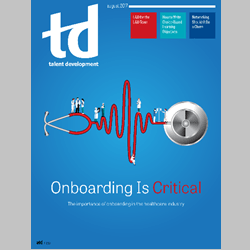TD Magazine Article
Onboarding Is Critical
The importance of onboarding in the healthcare industry
Tue Aug 01 2017

The healthcare profession is one of the fastest growing fields in the United States, with the need for such practitioners around the globe also at a critical level: The World Health Organization suggests that 80 million healthcare workers will be needed by 2030, with a shortage of 15 million workers.
Theresa Scepanski, senior vice president and chief administrative officer for organizational development at University Health System in San Antonio, Texas, explains that, for many years, there have been shortages in specialty areas, such as nursing, radiology, and pathology. Schools are limited in the number of students they can bring on in those fields and, by contrast, most communities have a large number of healthcare opportunities.
Talent shortages allow doctors, nurses, radiologists, and others in the field to be selective about where they work. For hospitals, healthcare systems, and related organizations, this has led to being stretched thin—and, for forward-looking organizations, to reconsider their talent development and retention practices.
Among those practices is employee engagement. While the phrase has become rather trite, it continues to be used because engagement is so critical. For organizations that realize its importance, it makes sense to start at the beginning: in onboarding.
What and why
"Onboarding is the process of acquiring, accommodating, assimilating, and accelerating new team members, whether they come from outside or inside the organization," write Ed Bancroft and George Bradt in their ATD Human Capital Blog post, "The Total Onboarding Program."
But it's also something that can be dismissed easily, especially in an organization where employees and resources are in short supply. Scepanski says that is penny-wise and pound-foolish: "Onboarding is critical in the sense that we want to make sure that the new employee connects with the organization, that they understand the commitment that they're making, and also the commitment the organization is making back to them." It's about ensuring that there is a successful, productive, healthy work experience for employees. To be effective, onboarding has to be engaging and relevant, and the new employee needs to walk away with a real appreciation about what the organization is all about, continued Scepanski.
To look at the raw numbers, 69 percent of employees with a great onboarding experience are likely to stay with their employer for at least three years, according to O.C. Tanner.
Industry challenges
Too few in healthcare have gotten the proverbial memo, however. Crystal J. Richards of Mosaic Resource Group has more than 15 years working with healthcare clients, and explains additional challenges: "Onboarding is based on antiquated, old-school methods. Rarely are the department heads or managers recruiting for talent. It is the human resources department that is responsible for recruitment, setting up the interviews, and onboarding and orientation."
This gets new employees off on the wrong foot. "By the time healthcare staff are in their departments, there is very little to no department onboarding. This is due to the 'this is the way we've always done things' mentality and the fact that, with staff shortages and meeting patient needs, the units rarely have the bandwidth to develop their own onboarding process. It's kind of trial-and-error onboarding," Richards adds.
This is true even though the data are out there for everyone to see. "This lack of buy-in to good onboarding is surprising on two fronts: First, hospitals and other healthcare organizations are among the most complex human organizations ever created and, second, buy-in can significantly reduce costly employee turnover in the first 24 months at a time when controlling expenses is a strategic imperative," states John G. Self, a recognized expert on candidate screening and selection who has worked extensively in the healthcare industry.
In addition to turnover, some organizations are encountering "new employees" not even showing up for work on day one. Richards says that happens despite formal employment letters being sent out and an offer being accepted. Such no-shows result in IT staff not necessarily going through the work of having computer accounts set up—including log-in information—ahead of time. And that, of course, leads to lost staff time, not to mention frustration on the part of the new employee who actually does come in for the first day on the job.
Even when organizations want to do the right thing, they might not know exactly how to make changes to their existing onboarding programs. Self puts it bluntly: "While most employee engagement and transition consultants agree on the definition of onboarding, very few agree on when it should begin, the scope and contents of what the process should include, or even how long the process should last."
How to go about it
As with much that goes on in an organization, a successful onboarding program really needs support from the top. Self says that "Without the CEO's endorsement, many healthcare organizations will play it safe and stick with their tried-and-true orientation programs at which the CEO may or may not make an appearance." But this is acting with shortsighted intentions. "Opposition to adding costs and a resistance to change are two of the most commonly cited reasons healthcare organizations cut this important corner," Self adds.
Scepanski explains that her health system recently revamped its onboarding program. In preparation for doing so, University Health System reps sought to learn from other organizations, both healthcare and non-healthcare ones. This included visiting MGM Grand in Las Vegas and participating in its orientation program after hearing the company's presentation at an ATD Learn From the BEST Conference session.
University Health System also sought feedback from its employees about the program. The culmination of its research and other work? "The Journey Begins Now," which is a two-day program for new employees that includes training from the organization's Center for Learning Excellence followed by instruction on the patient experience and an e-learning module. From there, new nurses go on to an additional training session. Departmental training/onboarding extends for 90 days; what is taught during the first two days is only what is absolutely critical for the first couple of days of employment, Scepanski says.
The revamping of the onboarding program includes a streamlining of benefits so that people who don't have questions can leave; for those who stay, the program is engaged with a lot of Q&A. The program also is designed to be active, with new employees up and out of their chairs.
Never too early to start
In one study, the Aberdeen Group reports that 4 percent of employees decide on day one whether they'll stay with the organization or move on—and 86 percent make that decision in the first six months.
So while the first two days are critical for new employees—and their organizations—Richards suggests starting even earlier and setting clear expectations. The facility might, for example, send out a packet that includes a welcome letter from the CEO, unit manager, HR, and maybe a card from the team.
Cabell Huntington Hospital in Huntington, West Virginia, features a video on its new employee onboarding site that spells out what incoming employees can expect—on two pre-employment appointments as well as on their first regular day of employment. Details include where to park, what to wear, and the process—functional capacity test, HR, registration, and laboratory—and location for each step.
Further, the video provides a phone number to call with any questions and a greeting of "we're glad you're here," both at the beginning and end of the video. The closing greeting is from the hospital's senior vice president/chief operating officer.
Additional words of wisdom
As Scepanski mentioned, asking employees about their onboarding experience can be beneficial, and it was something University Health System did when it reworked its onboarding. Richards also suggests asking employees during their exit interviews to find out what the organization might have done differently.
Playing off of Paul Spiegelman and Britt Berrett's book, Patients Come Second: Leading Change by Changing the Way You Lead, Self explains that "In healthcare, without a workforce of fully engaged employees, it is hard to sustain improved performance with quality, safety, and patient satisfaction. Taking care of your employees, from day one onward, will ensure improved performance across those critical criteria. Successful onboarding is essential to building this type of culture."
Self further recommends that organizations monitor employee turnover and add incentives to executives and management who examine at retention levels in relation to onboarding. A clearly defined job description with a list of performance deliverables will help recruitment and streamline the interview process so, Self elucidates, if you get the right candidates for the job, they are likely to assimilate more easily and quickly.
Transparency of culture also is essential. "Be transparent about the organization's culture. Every healthcare organization, from the large regional trauma center in a metropolitan city, to a 12-bed rural community hospital in a small ranching community, has good, bad, and ugly cultural qualities," Self shares. "Be honest with the candidates. Studies show that not understanding the culture or not being clear about performance deliverables are two of the most common reasons that candidates fail within the first 18 months of employment."
Teaming up
Within many clinical arenas, a new nurse (with limited nursing experience) is assigned a preceptor, someone who helps orient the new employee to the organization's clinical processes and standards of care. University Health System uses preceptors not just in clinical nursing roles, but in many roles involving direct patient care. Preceptors-to-be undergo training—learning about what is critical to focus on—prior to stepping into that role. The precepting relationship generally goes on for 90 days, though as Scepanski explains, certain roles such as those in the intensive care unit can go on for a longer period.
Self points to the potential benefits of creating a similar role, that of a "navigator," to help new employees—well beyond clinical roles—deal with logistical issues and to help humanize the environment for new employees. This can be likened to the navigator role sometimes involved in cancer treatment. As explained on the American Cancer Society website, "Patient navigation and advocacy now refers to almost anything being done to help patients and families find their way through the maze of our health care system."
Richards recommends the use of a mentoring program—a formal program, so it won't get swept by the wayside, but not too structured or regimented. The last thing that is needed is more documentation and paperwork required from nurses and other healthcare personnel. Richards suggests some level of training for mentors, something that benefits not only the mentee but could potentially help the mentor in future management roles.
Mentors usually are used on the nonclinical side at University Health System, according to Scepanski. Mentors go through training before assuming the role. The formal relationship usually extends for 90 days, but because mentoring is about a relationship, it often continues beyond the three-month time frame.
Happy employees, well-cared-for patients
In a May 2017 survey, the Medical Group Management Association found that 28 percent of respondents saw a staff turnover rate between 10 percent and 15 percent in the past year; 17 percent reported staff turnover of 16-20 percent; and 6 percent had more than 25 percent staff turnover in the past year.
And Gallup found that, in a study of 200 hospitals, engaged nurses are the number one correlative factor to mortality. Further, an HR Solutions study reports that 85 percent of engaged employees displayed a caring attitude toward patients, in contrast to 38 percent of disengaged employees.
It's time that healthcare organizations begin to pay attention to onboarding for the sake of employees, patients, and the organization as a whole.

